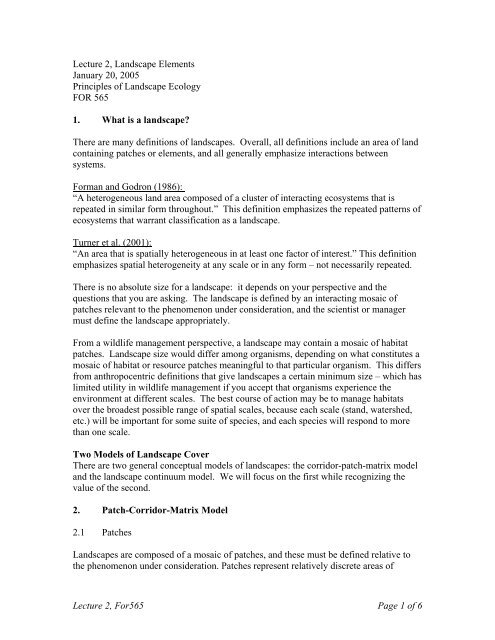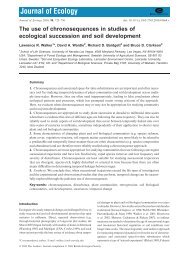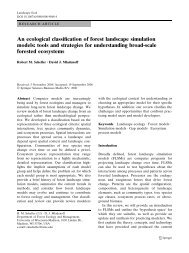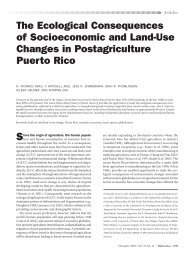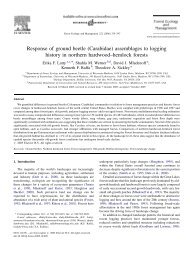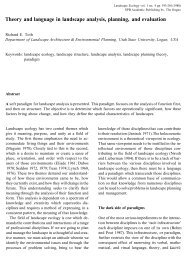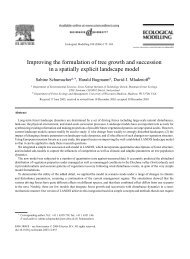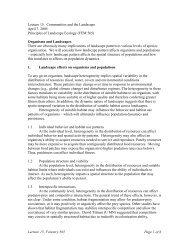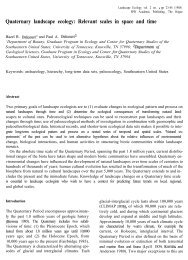Lecture 1 - Forest Landscape Ecology Lab, University of Wisconsin ...
Lecture 1 - Forest Landscape Ecology Lab, University of Wisconsin ...
Lecture 1 - Forest Landscape Ecology Lab, University of Wisconsin ...
You also want an ePaper? Increase the reach of your titles
YUMPU automatically turns print PDFs into web optimized ePapers that Google loves.
<strong>Lecture</strong> 2, <strong>Landscape</strong> Elements<br />
January 20, 2005<br />
Principles <strong>of</strong> <strong>Landscape</strong> <strong>Ecology</strong><br />
FOR 565<br />
1. What is a landscape?<br />
There are many definitions <strong>of</strong> landscapes. Overall, all definitions include an area <strong>of</strong> land<br />
containing patches or elements, and all generally emphasize interactions between<br />
systems.<br />
Forman and Godron (1986):<br />
“A heterogeneous land area composed <strong>of</strong> a cluster <strong>of</strong> interacting ecosystems that is<br />
repeated in similar form throughout.” This definition emphasizes the repeated patterns <strong>of</strong><br />
ecosystems that warrant classification as a landscape.<br />
Turner et al. (2001):<br />
“An area that is spatially heterogeneous in at least one factor <strong>of</strong> interest.” This definition<br />
emphasizes spatial heterogeneity at any scale or in any form – not necessarily repeated.<br />
There is no absolute size for a landscape: it depends on your perspective and the<br />
questions that you are asking. The landscape is defined by an interacting mosaic <strong>of</strong><br />
patches relevant to the phenomenon under consideration, and the scientist or manager<br />
must define the landscape appropriately.<br />
From a wildlife management perspective, a landscape may contain a mosaic <strong>of</strong> habitat<br />
patches. <strong>Landscape</strong> size would differ among organisms, depending on what constitutes a<br />
mosaic <strong>of</strong> habitat or resource patches meaningful to that particular organism. This differs<br />
from anthropocentric definitions that give landscapes a certain minimum size – which has<br />
limited utility in wildlife management if you accept that organisms experience the<br />
environment at different scales. The best course <strong>of</strong> action may be to manage habitats<br />
over the broadest possible range <strong>of</strong> spatial scales, because each scale (stand, watershed,<br />
etc.) will be important for some suite <strong>of</strong> species, and each species will respond to more<br />
than one scale.<br />
Two Models <strong>of</strong> <strong>Landscape</strong> Cover<br />
There are two general conceptual models <strong>of</strong> landscapes: the corridor-patch-matrix model<br />
and the landscape continuum model. We will focus on the first while recognizing the<br />
value <strong>of</strong> the second.<br />
2. Patch-Corridor-Matrix Model<br />
2.1 Patches<br />
<strong>Landscape</strong>s are composed <strong>of</strong> a mosaic <strong>of</strong> patches, and these must be defined relative to<br />
the phenomenon under consideration. Patches represent relatively discrete areas <strong>of</strong><br />
<strong>Lecture</strong> 2, For565 Page 1 <strong>of</strong> 6
homogeneous environmental conditions, where the patch boundaries are distinguished by<br />
environmental character states different enough from their surroundings that they may be<br />
perceived by or are relevant to the organism or process <strong>of</strong> interest.<br />
Patches are dynamic and occur on a variety <strong>of</strong> spatial and temporal scales. A patch at any<br />
scale includes patchiness at finer scales – and this mosaic <strong>of</strong> patches is defined by<br />
patchiness at broader scales. Thus any landscape contains a hierarchy <strong>of</strong> patch mosaics<br />
across a range <strong>of</strong> scales.<br />
2.1.1 Patch definitions<br />
In any case, methods are required for defining patches out <strong>of</strong> patchiness, only after which<br />
we can quantify and summarize various aspects <strong>of</strong> their pattern on the landscape. Patch<br />
boundaries are artificially imposed and meaningful only when referenced to a particular<br />
scale, and patches may be more distinct at some scales than others.<br />
First, we need to define the two ways that spatial (patch) data are stored: vector and<br />
raster data.<br />
Vector Data Data are stored in irregularly shaped polygons. In ArcGIS, these are called<br />
shape files or coverages.<br />
Raster Data. Data are stored in homogenous rectangles, typically squares. Also called<br />
lattice data, pixels, grains, grid cells. In ArcGIS, these are grids files.<br />
Both data types assume that the area within each unit (polygon or grid cell) is<br />
homogenous. 35mm photographs contain continuous data (limited only by the size <strong>of</strong> the<br />
molecule <strong>of</strong> the recording medium), however they must be converted to vector or raster<br />
data in order for us to use them in any meaningful way.<br />
There are four general approaches to defining patches.<br />
Simple aggregation <strong>of</strong> like-valued regions<br />
An easy method <strong>of</strong> defining patches is simply to combine all adjacent areas that have the<br />
same (or similar) value for the attribute <strong>of</strong> interest. A common methods is to cluster<br />
adjacent cells in a raster grid if the cells have the same value. All GIS packages have a<br />
utility to do this, and more complicated approaches can be devised for particular<br />
applications.<br />
Moving- or split-window methods<br />
An alternative approach is to define patches by defining their edges – that is, where the<br />
measured value changes abruptly. There are two general approaches:<br />
A. Local variance methods - Variance is computed within a moving window on a<br />
raster grid, with the variance saved as the value <strong>of</strong> the center cell <strong>of</strong> the window for a new<br />
data grid. Regions where the values change will have high local variance.<br />
B. Local rate-<strong>of</strong>-change - Similarly, one could calculate a local regression on X and Y<br />
coordinates and then consider the slope <strong>of</strong> this regression as an indication <strong>of</strong> the rate-<strong>of</strong>change;<br />
areas <strong>of</strong> steep slope indicate edges <strong>of</strong> patches.<br />
<strong>Lecture</strong> 2, For565 Page 2 <strong>of</strong> 6
In either case, a surface plot <strong>of</strong> this local variance or slope will "outline" patches <strong>of</strong><br />
comparative homogeneity. In a GIS, one could compute a local variance, then threshold<br />
this value to create vectors <strong>of</strong> values above the threshold, ultimately joining these into<br />
polygons. A useful feature <strong>of</strong> this approach is that it provides a measure <strong>of</strong> edge width<br />
and contrast (e.g., whether the edges are abrupt or "fuzzy"), which might be useful in<br />
some applications. This method also requires a fairly extensive initial landscape map.<br />
Global zonation or Iterative Splitting<br />
Another alternative is to use a divisive approach, beginning with a single patch (the entire<br />
study area or data set) and then successively dividing this into regions that are statistically<br />
similar. The basic approach is to iteratively divide the region into all possible pairs <strong>of</strong><br />
sub-regions, and then compare the variances between sub-regions relative to the internal<br />
variances for each sub-regions (an F test). The data split that maximizes the between-subregion<br />
variance finds the most homogeneous sub-regions. This procedure is then repeated<br />
recursively. This can be computationally complex for large data sets.<br />
Spatially constrained clustering<br />
A final method to create patches is to cluster them hierarchically, but with a constraint <strong>of</strong><br />
spatial adjacency. In this, a multivariate agglomerative clustering algorithm is extended<br />
to enforce the condition that groups are joined only if spatially adjacent (with adjacency<br />
defined for the application).<br />
2.1.2 Patch Characteristics<br />
Patches can be characterized compositionally in terms <strong>of</strong> the variables measured within<br />
them. This may include the mean (mode, central, or max) value and internal<br />
heterogeneity (variance, range). In spatial applications, we want additional information<br />
about the patch's shape or spatial configuration. A patch can be described by its:<br />
A. Area. The size <strong>of</strong> the patch, in units <strong>of</strong> map scale or as a proportion <strong>of</strong> the total<br />
map area. Area may also be subdivided into edge versus interior (core) area, with edges<br />
defined in terms <strong>of</strong> some buffering distance.<br />
B. Perimeter (edge length). The linear measure <strong>of</strong> patch circumference.<br />
C. Shape complexity A measure <strong>of</strong> how irregularly a patch is shaped. For example,<br />
the shape <strong>of</strong> Alaska is more complex than Kansas. Shape complexity is <strong>of</strong>ten<br />
summarized in terms <strong>of</strong> the edge to area ratio.<br />
Most methods that define patches (especially GIS) provide these indices simply or even<br />
automatically. Virtually all GIS packages calculate the area and perimeter (edge length)<br />
<strong>of</strong> each patch. During our second lab, we will be using a simpler program (IAN) that<br />
calculates these (and many other) metrics automatically.<br />
2.2 Corridors and Edges<br />
Corridors are essentially a unique sub-set <strong>of</strong> patches. Corridors are defined as narrow,<br />
linear patches <strong>of</strong> a patch type that differ from those on either side. Corridors are<br />
important in that they may also function as habitat, dispersal vectors, or barriers as a<br />
consequence <strong>of</strong> their structure. Corridors may be either temporary or permanent for the<br />
process or organism <strong>of</strong> interest.<br />
<strong>Lecture</strong> 2, For565 Page 3 <strong>of</strong> 6
Three types <strong>of</strong> structural corridors exist:<br />
A. Line corridors. The width <strong>of</strong> the corridor is too narrow to allow for interior<br />
environmental conditions to develop<br />
B. Strip corridors – the width <strong>of</strong> the corridor is wide enough to allow for interior<br />
conditions to develop<br />
C. Stream corridors – totally different, special category<br />
Functionally, corridors may be categorized differently. Several functions have been<br />
documented:<br />
A. Habitat corridor – Linear landscape element that provides habitat for<br />
survivorship, natality, and movement. Habitat corridors tend to increase the connectivity<br />
<strong>of</strong> a landscape.<br />
B. Facilitated movement corridor – Linear landscape element that provides for<br />
survivorship and movement, but not necessarily natality, between other habitat patches.<br />
Facilitated movement corridors also tend to increase connectivity.<br />
Most attention has been on facilitated movement corridors. Some have argued that we<br />
can only demonstrate this corridor function when the rate <strong>of</strong> immigration to the target<br />
patch increases above what it would be without the corridor. As in many aspects <strong>of</strong><br />
landscape ecology and ecology in general, this has not been experimentally tested.<br />
C. Barrier or filter corridor – Linear landscape element that prohibits or<br />
differentially impedes (filters) the flow <strong>of</strong> materials or organisms. Barrier/filter corridors<br />
decrease matrix connectivity.<br />
D. Modifying Corridor - The corridor or edge modifies the effect <strong>of</strong> abiotic or<br />
biotic effects on the surrounding matrix. The edge modifies the inputs materials and/or<br />
organisms between two patches or between a patch and the surrounding matrix.<br />
Edges are a unique type <strong>of</strong> corridor. Between every two patches lies an edge. Edges are<br />
rarely as abrupt as depicted in any GIS. Rather, edges will be structurally complex and<br />
may contain unique elements <strong>of</strong> both neighbors. The measurement <strong>of</strong> edges was<br />
discussed alongside patch definitions. In general, edges are much more difficult to define<br />
than patches. Edges most <strong>of</strong>ten function as barrier/filter corridors (C) or produce unique<br />
effects on the patch or matrix (D).<br />
An example is the forest edge: next to a clearcut, the forest edge will experience greater<br />
mortality than the interior. There are important and significant effects on light<br />
transmittance, moisture, and temperature both within the edge and on the neighboring,<br />
more interior forest. The species richness <strong>of</strong> understory plants will also be greater near<br />
the forest edge (but may be less unique).<br />
<strong>Lecture</strong> 2, For565 Page 4 <strong>of</strong> 6
2.3 Matrix<br />
The matrix is considered the most common or connected landscape element type, and<br />
thus plays the dominant role in landscape function. The matrix is obvious in many cases,<br />
but not always (thus leading to the landscape continuum model, below), and it may not be<br />
appropriate to consider any specific landscape element the matrix. The matrix should be<br />
defined based on the object or process under consideration and the scale <strong>of</strong> investigation.<br />
What may seen to be a “fragmented” matrix or landscape at one scale may only be an odd<br />
inclusion at a different scale, depending on the abundance and configuration <strong>of</strong> the<br />
patches in question.<br />
2.4 Limitations <strong>of</strong> the patch-corridor-matrix model<br />
Other than the fact that the matrix is not always easily defined or distinguished, the P-C-<br />
M model has been criticized for being over-simplistic. Classifying landscapes into<br />
patches and corridors that contrast with the matrix are essentially human constructs that<br />
are facilitated by mapping tools (GIS). Humans and other organisms may perceive and<br />
(or) perceive such landscape elements in very different ways.<br />
In addition, the P-C-M model sometimes suffers from the binary classification <strong>of</strong> habitat<br />
into suitable vs. unsuitable habitat when habitats for species most <strong>of</strong>ten occur on a<br />
gradient. Notably, the patches and corridors defined by the P-C-M model themselves<br />
contain interior heterogeneity that may affect species and/or processes that occur with the<br />
elements.<br />
3. The <strong>Landscape</strong> Continuum (LC) Model<br />
In landscapes where patches are not discrete or obviously defined, patches may not be<br />
easily differentiated from the matrix. The landscape continuum model was developed in<br />
response to this issue, originally for semi-cleared grazing and agricultural landscapes in<br />
Australia that had small fragments <strong>of</strong> woodlands and isolated, scattered native trees.<br />
Patches and corridors are too difficult to define in this setting and others (like grasslands).<br />
Although single trees may not provide habitat for some taxa, a set <strong>of</strong> isolated trees may<br />
collectively provide habitat – so these small elements should be considered rather than<br />
absorbed into the background matrix. The LC model was developed as a improvement<br />
over the P-C-M model, which <strong>of</strong>ten inaccurately assumes the matrix to be “unsuitable”<br />
and patches to be “habitat islands”.<br />
As one example, the model can contain four broad cover classes:<br />
A. Intact cover – containing >90% cover and having low levels <strong>of</strong> modification.<br />
B. Variegated cover – containing 60-90% cover and variable levels <strong>of</strong> modification<br />
– matrix still consists <strong>of</strong> suitable habitat.<br />
C. Fragmented cover – containing 10-60% cover and variable levels <strong>of</strong><br />
modification – but matrix is now unsuitable or “destroyed” habitat.<br />
D. Relictual cover – containing < 10% cover and usually high levels <strong>of</strong><br />
modification.<br />
<strong>Lecture</strong> 2, For565 Page 5 <strong>of</strong> 6
The LC model recognized that landscapes are more complex than described by the patchcorridor-matrix<br />
model, which contains only very discrete landscape conditions, where<br />
patches and corridors are distinct from the matrix. Recognition that a landscape may be<br />
highly variegated rather than a series <strong>of</strong> discrete patches may provide additional<br />
information in landscapes where strict ‘patches’ do not exist.<br />
3.1.1 Limitations <strong>of</strong> the landscape continuum model<br />
The landscape continuum model is subject to issues <strong>of</strong> scale as is the P-C-M model –<br />
what is variegated to one organism may not be to another, and what is fragmented at one<br />
scale may not be at another. Likewise, the LC model also considers only binary measures<br />
<strong>of</strong> habitat – suitable vs. non-suitable – rather than gradients, and can also be<br />
anthropocentric.<br />
3.2 Overlap between P-C-M-E and LC Models<br />
In as much as the two models differ, they also contain similar components. The primary<br />
difference is the level <strong>of</strong> focus – the PCM model focuses more on the elements <strong>of</strong> the<br />
landscapes - the size and shape <strong>of</strong> patches and corridors – while the LC model tends to<br />
focus more on whole landscapes. However, both consider the matrix to be the dominant<br />
element on the landscape, both are subject to similar issues <strong>of</strong> scale, and both suffer from<br />
similar limitations.<br />
So which is better? Ecologists – and scientists in general – like to simplify and<br />
generalize. This is extraordinarily difficult to do on landscapes because they are so<br />
exceedingly complex. This complexity has attracted people more towards the PCM<br />
model for its simplicity, at least when patches are easily defined – although the use <strong>of</strong> this<br />
model has also guided the way we study landscapes.<br />
<strong>Lecture</strong> 2, For565 Page 6 <strong>of</strong> 6


